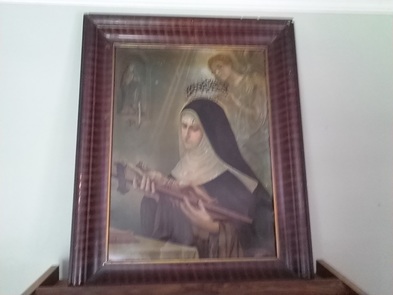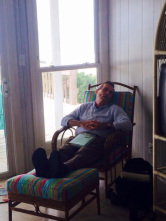
In this painting Saint Rita of Cascia meditates on a crucifix while an angel holds a crown of thorns above her head. To her right a statue of the Virgin Mary occupies a niche in the wall. Visible, if you look intently, is the gash in Rita’s forehead, which appeared while she was praying at age sixty before an image of Christ, a wound considered by her admirers a partial stigmata.
A brief history: Rita was married at age twelve to an abusive husband, who was later murdered in a blood feud with another family. After the deaths of her two sons, Rita spent forty years as a sister in an Augustinian convent. Today she serves as the patroness of abused wives and heartbroken women. At the time of her canonization in 1900, the Church also gave her the official title of “Patroness of Impossible Causes.”
A brief history: Rita was married at age twelve to an abusive husband, who was later murdered in a blood feud with another family. After the deaths of her two sons, Rita spent forty years as a sister in an Augustinian convent. Today she serves as the patroness of abused wives and heartbroken women. At the time of her canonization in 1900, the Church also gave her the official title of “Patroness of Impossible Causes.”
This painting interests me less for its subject than for its materials. First, the artist finished the painting without affixing a signature or date, leading me to believe that perhaps a nun, acting with that artistic anonymity practiced long ago in the Middle Ages, simply put down her brush after the last stroke and walked away. Next, the artist chose as her canvas a rectangle of tin measuring 18” by 24”, held to its wooden frame by 54 nails. Why tin? I wonder from time to time. Was the artist too impoverished for canvas and stretchers? Did she prefer to work in this medium?
What brings true meaning to the painting, however, is the man who gave it to me: Father Tom Stott.
In 1992, Father Stott arrived as the new priest of our Waynesville parish exactly one week after I was received into the Catholic Church. He was a short, stocky man, about 5’5”, with black hair, black eyebrows, and cheeks darkened by noon with a five o’clock shadow, features reflecting his mother’s Italian roots.
Some say that good things come in little packages. True, but so does dynamite.
My entrance into the Church was preceded by nine months of instruction with Father Gray, one of two Redemptorist priests at St. John’s. During this time of learning about the Faith and attending Mass, I became acquainted with many members of our parish. On learning that the bishop had appointed a diocesan priest to replace the Redemptorists, who belonged to a religious order and who were departing to minister to another church, some of these parishioners expressed trepidation. They preferred the easy-going Redemptorists, with whom they were familiar, to a diocesan priest, a man directly answerable to the bishop. They feared the new man might bring disagreeable changes.
Their suspicions were justified. Changes were made. Whether they were disagreeable depended on your point of view.
Some newly appointed priests, wishing to introduce different practices or abolish ones they find innocuous, do so in a slow, incremental fashion, pausing after each alteration to give parishioners a chance to adjust and accept the new way. Others, however, jump right into the fray, tossing out the old and ringing in the new with utter abandon. The two approaches bear comparison to the perpetual debate over how to enter a cold swimming pool: Do you wade into the chilly water foot by foot or simply take a flying leap and end the misery in a single splash?
Father Stott was a flying leaper.
In the first month, in the sanctuary on the walls between the Stations of the Cross, Father Stott hung some thirty relics, tiny chips of bone or bits of clothing taken from the remains of dead saints and enclosed in small silver cases with glass windows displaying the relic. He let the cook and the bookkeeper go, asserting these positions were too great a luxury for such a small parish. He chided the parish council for wasting money. He offended women accustomed to their advice being taken as gospel—pardon the pun—by the resident priest. He admonished certain young women to dress more modestly for Mass.
On one of these occasions regarding dress, I nearly burst out laughing. During the summers, tourists swelled attendance at Mass, often forcing a number of people to stand at the back of the church. On this particular Sunday, Father Stott and some of the ushers set up a row of folding chairs in front of the church, at which point Father mounted the lectern, bent over the microphone, beamed at the women standing at the back of the church, and announced: “Ladies, if your skirts are long enough, you’re welcome to sit in the chairs at the front.”
As upsetting as these transformations were to some people, Father Stott’s celebration of Mass, his liturgical practices, and his homilies were the fuses igniting the dynamite. He was one of the rare priests who employed the beautiful Eucharistic Prayer I, yet some parishioners criticized it as “too old-fashioned.” He preceded some Masses with Adoration. He once quoted part of the Athanasian Creed from the pulpit, including its opening line “Whosoever will be saved before all things, it is necessary that he hold the catholic faith.” Once he refused communion to a man who had denied certain points of Catholic dogma. Every Sunday he preached the doctrines of the Faith, standing with the Church on everything from the Virgin Birth to abortion.
Given that we were, after all, Roman Catholics, you might think the people of the parish would appreciate the beauty of these liturgical practices and the solid Catholic teaching. Such was not the case. Of the relics, one woman in the middle of Mass once tugged at my sleeve and gestured with her chin at the wall beside us. “What do you think of those bones?”
I shrugged, unwilling to converse during the service.
“Well, I think they are just plain morbid,” she said.
Other took umbrage at homilies on abortion, on the Assumption, on the perpetual virginity of Mary.
Perhaps the reaction of one parishioner might best sum up the attitudes of those opposed to Father Stott.
One Sunday after Mass, I was standing outside the church chatting with friends when a large woman burst out of the vestibule and charged down the steps, shouting angrily to a group of her acquaintances: “He actually wants us to believe what the Pope believes.”
“I thought that was the point,” I said calmly, but in her anger she didn’t hear me.
It was at that moment my honeymoon with my Faith ended.
(To be continued)





 RSS Feed
RSS Feed